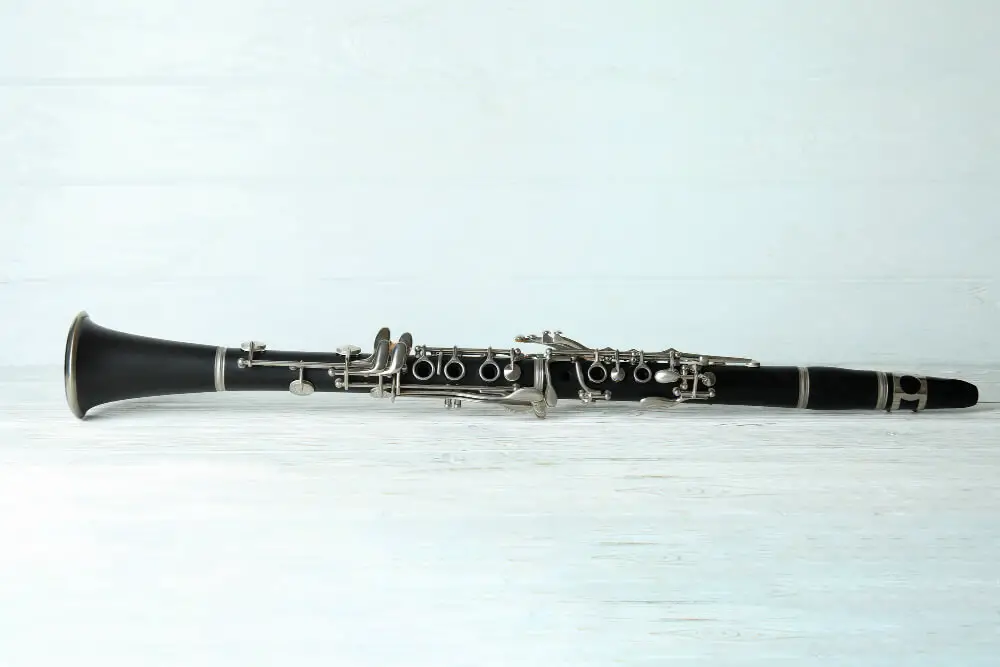Many people have the impression that, with regular care and cleaning, a clarinet can last forever because of its apparent simplicity and durability, this is not true, although high-quality instruments can last for decades.
However, a professionally played clarinet, such as a Buffet pre-R-13, can last for up to 30 years with regular care.
Clarinets, like many other instruments, deteriorate over time. Keys and springs need to be rebent, and pads and cork joints need to be replaced.
Over time, the tone holes in clarinets that get a lot of use can wear down and leak. There’s a chance cracks will show up, too. The clarinet as a whole lasts much longer before the reed and mouthpiece start to fail.
Under “normal” (non-professional) use, a clarinet will gradually lose some of its parts due to wear and tear (read on for more). Ongoing maintenance can extend the life of these components.
Some clarinets are much more durable than others due to their superior construction. It is possible that, even after years of professional use, a high-end clarinet could “blow out.”
It is possible that, even after years of professional use, a high-end clarinet could “blow out.”
“Blown out” clarinets
The term “blown out” is used to describe clarinets that have worn out to the point where they can no longer be used professionally. The main reason for this is a change in the tone holes’ and bore’s dimensions, which affects the sound.
A clarinet that has “blown out” has significantly degraded over time. This may occur as a result of the overall resistance of the sound changing, the tone holes wearing out, or the bore and/or barrel distorting.
Blown-out clarinets lose their focus over time. Depending on the instrument’s history and how it was handled, it may be possible to restore it by replacing the barrel and/or the bell.
Clarinet parts that wear out

Clarinets and other woodwind instruments react strongly to changes in humidity and temperature. A spring or other metallic component of the instrument will not wear out quickly but will rust. Some of the more fragile components are as follows.
Tone holes: They are the main source of leakage in a clarinet. Since it’s made entirely of wood, the tone seats will eventually break off once the wood deteriorates. This results in a larger hole.
Pads: The material used to make a pad is a major factor in how long it will last. However, regular use will eventually cause the pads to come loose and fall off of your clarinet. While it is possible to glue them back into place, it is recommended that worn cork pads be replaced with new ones.
Springs: Even though they last as long as the clarinet itself, springs can occasionally become misaligned and need to be realigned. They aren’t easily broken, but they can be damaged if bent too sharply.
Expansion of the bore poses a threat to the structural integrity of the clarinet as a whole and can cause cracks.
Can mouthpieces become worn out?
It would be impossible to play your instrument without the mouthpiece. It is responsible for producing the sound that the bell makes along with the reed.
Typically, a mouthpiece will be made of plastic. As a result, they are frequently not as strong as you might imagine.
When you blow into the mouthpiece, the reed moves against the mouthpiece rail as it vibrates. The more frequently you use the mouthpiece, the faster it will wear out.
Each component is crucial to the creation of sound. The sound quality suffers if any of the four components—the table, rails, baffle, or lay—are in poor condition. If the lay on one side cracks for whatever reason, the reed in the mouthpiece becomes unstable.
As a result, the worst that can come out of the mouthpiece is an unpleasant squeak. Dropping your mouthpiece on the floor can cause serious damage. If it falls from a great height, it is likely to crack.
Because of the nature of plastics, the thin table wraps when exposed to high temperatures. High temperatures do not only include fire. When exposed to sunlight, it softens and may become unplayable.
You should also regularly clean your mouthpiece. However, be careful not to use poor quality or abrasive swabs as you clean it. The mouthpiece and swab must remain scratch-free during the cleaning process. A cotton or silk swab is preferable because it won’t leave any residue behind if it gets damaged.
An important thing to look out for regarding your reed is to make sure the tip isn’t chipped. In the event of a broken tip, the reed must be replaced and cannot be repaired.
Do clarinets have a lifespan?
For all clarinets, it is impossible to specify a specific time range. If used properly and maintained well, a high-quality instrument can retain its value for quite some time.
The higher the quality of your instrument, the longer it will last. A student clarinet that isn’t very good tends to lose a lot of its good qualities and value after ten years. However, a professionally played instrument, such as a Buffet pre-R-13, can last for up to 30 years with regular care.
Evidently, the lifespan of a clarinet is also affected by how often it is played. If you play your clarinet for six hours a day, every day, it will likely start to lose its quality within 10–11 years.
As with any tool, the more you use it, the faster it will wear out, but if you use it less frequently, it will last longer. Less frequently used clarinets by amateurs have a higher likelihood of lasting longer than 20 years.
Even if your clarinet still works after 20 years of use, its parts will eventually wear out from all that repeated motion. The pads, for instance, can become discolored and loose over time.
It’s possible that you’ll need to invest some cash into repairs. It may be more cost-effective to purchase a new instrument than to have it repaired.
Despite the fact that clarinets can last for more than ten years, mouthpieces typically don’t last quite as long. They are a more troublesome component to maintain due to their extreme fragility. After about two to three years of consistent use, the tip cracks and the overall sound quality suffers.
When do clarinets require maintenance?
While it’s true that over time, a clarinet’s performance can decline, this doesn’t always necessitate a full replacement. In actuality, you should typically service your instrument before it wears out. Clarinets need to be serviced once every 12 to 18 months.
Tone holes
The tone holes are the primary focus of any maintenance procedure. Tone holes can be a bit of a challenge. Wood is not a sturdy or reliable material. As a result of being subjected to moisture and extreme temperatures, the tone holes’ surface gradually deteriorates over time.
Clarinet technicians will inspect the tone holes for damage before repairing your instrument. Next, the seats in the tone holes are reupholstered to prevent any further leakage.
Springs and pads
If the springs aren’t providing enough tension, they should be adjusted with a screwdriver and pliers. Spring tension adjustment is a delicate process, and it is recommended that a professional do it.
Pads can be easily replaced for a quick and easy DIY repair. The pads should be securely reattached with glue if they seem to be coming loose.
Greasing
Another typical maintenance advice is to apply grease. When joints are tight, a small amount of grease is okay. However, since cork absorbs grease over time, doing so daily isn’t a good idea.
This causes the cork to fall apart as it dissolves the adhesive holding it to the body. During maintenance, you will need to replace the cork if it is damaged in any way.
How frequently must clarinet pads be changed?
Pads for clarinets vary in quality. Materials range from leather and cork to silicon and new synthetic materials. These materials all have their advantages and disadvantages. Therefore, the frequency of pad replacement is dependent on the pad’s material.
Leather pads
The most popular kind of clarinet pads are leather, and they work well for intermediate clarinetists. Their main drawback is that leather is extremely sensitive to moisture.
Whenever a leather pad gets wet, it tends to dry out and become brittle. Because of the leaking that happens at the tone hole, this gradually affects the sound.
The wetter the leather pad, the faster this happens. Typically, you should think about getting new leather pads once a year.
Pads made of silicon and cork
Pads made of water-resistant materials, such as silicon and cork, have a longer lifespan. Silicon does not degrade or change shape when exposed to moisture.
Silicon pads aren’t popular among all clarinetists because, unlike leather pads, they don’t swell to cover the tone holes when a key is bent slightly.
Silicon pads, however, don’t stay put on most surfaces because of the material’s inherent properties. Therefore, the pad needs to be replaced frequently because it frequently falls off during performances and rehearsals.
Cork pads are highly elastic and comparable to silicon pads. After about five years, they become worn and need to be replaced. Silicon pads, on the other hand, can serve their purpose for up to ten years if they aren’t misplaced.
Newer pads
If you’re looking for the best sound quality, look no further than the silicon resonance pads or any of the other cutting-edge new pad technologies available today.
They are utilized in modern, expensive clarinet models. They’re built to withstand severe conditions and can supposedly go decades without being replaced.
Is it possible to fix a clarinet that has a crack in it?
The primary causes of cracks are changes in temperature and humidity. It’s not easy to fix a cracked clarinet. However, damage from cracks can be repaired.
Clean the cracks and affected joints before taking it in for repair to avoid any complications with the cracks being sealed. To properly repair the crack, a technique known as ‘pinning’ is used.
To prevent further cracking, pins are carefully inserted into the wood, taking care to avoid the bore of the instrument.
After the crack has been sealed and the pins have been inserted, Cyanoacrylate adhesive and Granadilla dust are used to conceal the pinholes and crack lines.







